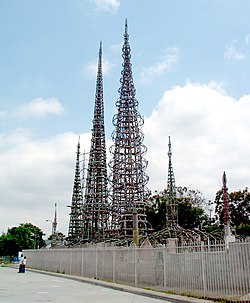Watts Towers of Simon Rodia State Historic Park
|
Watts Towers of Simon Rodia
Simon Rodia State Historic Park |
|

Watts Towers
|
|
| Location | 1727 E. 107th Street, Los Angeles, California 90002 |
|---|---|
| Coordinates | 33°56′19.46″N 118°14′27.77″W / 33.9387389°N 118.2410472°WCoordinates: 33°56′19.46″N 118°14′27.77″W / 33.9387389°N 118.2410472°W |
| Built | 1921–1954 |
| Architect | Sabato Rodia |
| NRHP Reference # | 77000297 |
| CHISL # | 993 |
| LAHCM # | 15 |
| Significant dates | |
| Added to NRHP | April 13, 1977 |
| Designated NHL | December 14, 1990 |
| Designated CHISL | August 17, 1990 |
| Designated LAHCM | March 1, 1963 |
The Watts Towers, Towers of Simon Rodia, or Nuestro Pueblo ("our town") are a collection of 17 interconnected sculptural structures within the Simon Rodia State Historic Park in the Watts community of Los Angeles. The tallest of the towers reaches a height of over 99 feet (30 m). The towers and walls were designed and built by Sabato ("Simon") Rodia (1879-1965), an Italian immigrant construction worker and tile mason, over a period of 33 years, from 1921 to 1954. The work is an example of outsider art and Italian-American naïve art.
The Watts Towers are located near the 103rd Street/Watts Towers Los Angeles Metro station of the Los Angeles County Metro Rail Blue Line, and off the I-105 Century Freeway. They were designated a National Historic Landmark and a California Historical Landmark in 1990. They are also a Los Angeles Historic-Cultural Monument, and on the National Register of Historic Places in Los Angeles.
The sculptures' armatures are constructed from steel rebar and Rodia's own concoction of a type of concrete, wrapped with wire mesh. The main supports are embedded with pieces of porcelain, tile, and glass. They are decorated with found objects, including bottles, ceramic tiles, seashells, figurines, mirrors, and much more. Rodia called the Towers "Nuestro Pueblo" (which means "our town" in Spanish). He built them with no special equipment or predetermined design, working alone with hand tools. Neighborhood children brought pieces of broken pottery to Rodia, and he also used damaged pieces from the Malibu Pottery and CALCO (California Clay Products Company). Green glass includes recognizable soft drink bottles from the 1930s through 1950s, some still bearing the former logos of 7 Up, Squirt, Bubble Up, and Canada Dry; blue glass appears to be from milk of magnesia bottles.
...
Wikipedia



